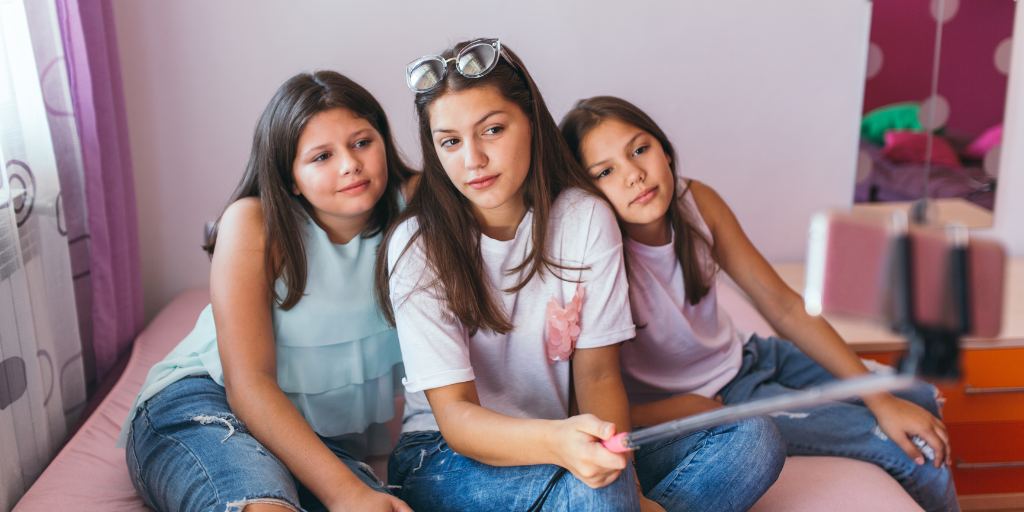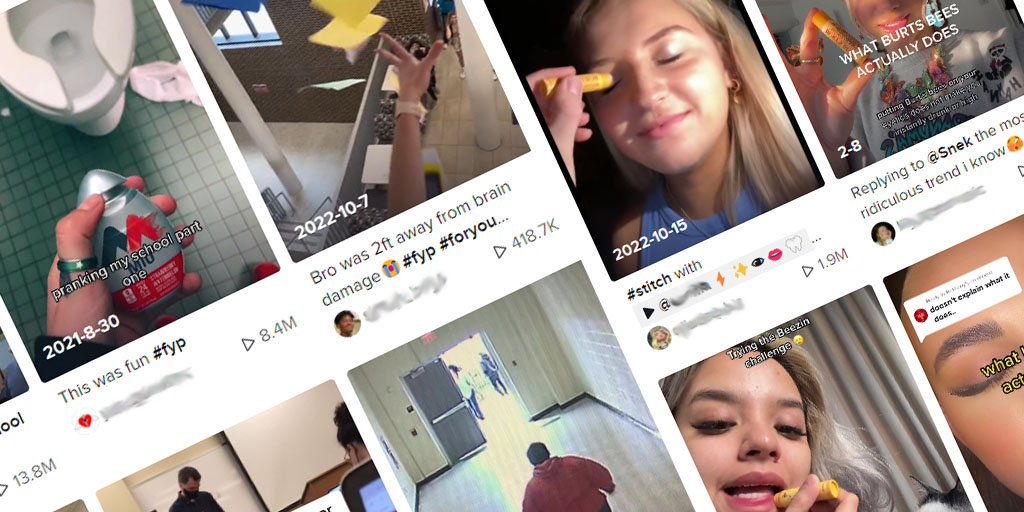
From flat-earthers, to QAnon, to PizzaGate, and even the Titanic, the internet is rife with conspiracy theories — and teens are particularly susceptible to them. Read on for more information on conspiracy theories in the digital era, along with tips on talking about them with your kids.
Conspiracy theories pop up everywhere, but they have particularly problematic histories on YouTube and TikTok. This is a challenge given how much time tweens and teens spend on social media — often several hours a day. There’s also concern among some researchers about the role gaming platforms can play in spreading misinformation and conspiracy theories.
“On social media, repetition substitutes for validation,” Russel Muirhead, a Dartmouth College professor and co-author of "A Lot of People Are Saying: The New Conspiracism and the Assault on Democracy" told Wired in 2020. “Repetition is what breathes air into conspiracy theories, and social media is all about repetition.”
Several studies have shown 14-18 year-olds to be especially susceptible to conspiratorial thinking. The teenage years are a time when kids are looking for community and seeking significance — both of which some people find in conspiracy theories. Add this to teenagers’ still-emerging critical thinking skills, and you have the perfect breeding ground for falling prey to conspiracies. Disinformation campaigns and unmonitored algorithms take advantage of this and often directly seek out younger users on these platforms to steer them toward more misleading content.
Here are a few things that may indicate your child is engaging with conspiracy theories:
A recent study examining the relationship between social media and conspiracy theories found that the more likely a person is to believe conspiracy theories, the more social media influences their thinking. So, preventing your child from believing in conspiracy theories in general is the best way to prevent them from falling down social media conspiracy theory rabbit holes.
Here are a few actions you can take to help prevent your child from adopting a conspiracy mindset in the first place:
Allow your child to share their beliefs without fear of judgment or ridicule. Rather than scolding them for differing beliefs, encourage them to explain how their opinion was formed and then respectfully introduce other possibilities. The more they feel comfortable sharing their beliefs with you, the more of a role you can play in steering them away from conspiracy theories.
Simply telling your children what to think teaches them to blindly accept what they’re told. This lack of questioning may open them up to conspiracy theories. Instead, explain why you believe what you do and how you formed those beliefs. Ask them what they think and be open if they express opinions different from your own.
Promote evidence-based thinking with your children by showing them how to seek out credible sources. Talk through common conspiracy theories with your children to demonstrate how to spot them.
Periodic check-ins on your child’s digital activity, as well as monitoring tools, make it more likely you’ll spot a problem with conspiracy theories early so it can be promptly addressed.

As a parent, you can do everything possible — and your kid may still fall for a conspiracy theory. Fortunately, there are strategies you can take to help them.
The internet is full of conspiracy theories, and teens are particularly susceptible to them. With the right approach, you can decrease the chances of your child getting caught up in conspiracy theories and help them think critically if they do fall for one.

Parenting myths have a way of persisting, especially when it comes to raising kids in today’s tech-driven world. Some of those myths include the belief that all screen time is bad for kids and that a child is safe online as long as they don’t use social media. Breaking these misconceptions is a vital step toward keeping your child safe and healthy online.
Here are 7 myths of the most common digital parenting myths — and what you should know instead.
False. Social media poses some of the biggest risks to kids. But there are plenty of other places they may run into trouble online, such as inappropriate content on YouTube, online predators in forums, and cyberbullying in toxic group threads.
False. Parental controls are fantastic tools that can limit your child’s exposure to things you don’t want them to easily access. But they aren’t foolproof. They work best as part of a broader strategy that includes open communication and real-time monitoring.
False. The part of the brain responsible for impulse control and decision-making doesn’t fully develop until around age 25. Kids have a hard time resisting the instant gratification from using a device, and they’re limited in their ability to think about the consequences of their actions online.
False. Not all screen time is harmful because not all screen time is created equal. There are even potential benefits with educational apps, video chats with family, or creative tools like music and animation. The difference is whether screen time is active or passive.
False. Many kids hide their online issues out of fear of losing their device or getting in trouble. Consciously working to foster open communication with your child helps, but it’s still not a guarantee they won’t keep something important from you.
False. This myth continues to persist, despite ample research disproving that video games cause violent behavior. That said, it’s still important to stay involved in your child’s gaming habits and know what kind of content they’re consuming.
False. Your tech-savvy kid may be able to run circles around you when it comes to the technical side of things. But they lack the emotional maturity to navigate online threats like cyberbullying, grooming by predators, and misinformation. That’s where you come in.
There are many myths about parenting in the digital age that are downright false, such as believing if your child knows more about technology than you do, there’s nothing you can do to help them maneuver life online. It’s important for parents to bust these myths and educate themselves about the reality of raising kids in the era of the internet.
BrightCanary can help you supervise your child online. The app’s advanced technology scans their online activity (including social media, texts, YouTube, and Google searches) and updates when they encounter something concerning. Download the app and get started for free today.

Some parents choose to block websites in order to prevent their child from being exposed to inappropriate content online. If you’re considering this route, you may be wondering, “What websites should I block for my child?”
Read on to learn how to block websites, what websites to start with, and additional tools for keeping your child safe online.
There are a variety of reasons why parents might choose to block websites for their child — some universal, others specific to their family’s unique circumstances. As you decide if you want to block websites for your own kid, here are some factors to consider:
There are a variety of ways to block websites you don’t want your child visiting.
On your child’s device. In most cases, you can disallow specific websites directly on your child’s phone or tablet. If they use an iPhone, this can be done with Apple Screen Time under “Content & Privacy Restrictions.”
Parental controls. Google Family Link and Apple parental controls allow parents to block websites through their accounts.
In the browser. Blocking can also be done at the browser level, although this isn’t usually the easiest method.
What websites you block for your child will largely depend on why you decided to do it in the first place. Here are some types of websites to consider blocking:
Pornography websites like Pornhub are at the top of most parents’ lists of what to block for their child, as are adult chat sites and forums with no age limits.
Online communities such as 4chan and 8chan — which are known as hubs for extremist beliefs, hate speech, and threats of violence — are not appropriate for kids.
Websites like Reddit, which has weak privacy settings, problematic content, and a track record as a home for dangerous trends, are not a good place for children to hangout online.
The internet is a vast place, filled with infinite corners where questionable content can lurk. Trying to block each and every site you don’t want your child to visit can be a bit like playing Whac-A-Mole — smack down one and another will quickly fill its place.
For parents looking to curate the content their child can view online, filters are a more flexible and effective option. Filters allow you to set limits based on both your child’s age and types of content, providing a larger safety than blocking individual websites. For example, on Apple devices, you can filter out adult websites.
In addition to blocking or filtering websites your child can visit, it’s also a good idea to monitor their internet use and searches. Keeping tabs on what they search for will alert you to potential red flags so you can follow up and take steps to keep your child safe.
We recommend BrightCanary, which uses advanced technology to monitor what your child types on all the apps they use, including Google searches, incognito browsers, and texts and social media. The app will notify you if there’s an issue and offer detailed summaries in an easy-to-use dashboard. Even better — BrightCanary integrates well with Apple parental controls on iOS.
While blocking websites can be useful for families looking to limit the content their child can view, it’s far from a foolproof plan. Web filtering and regular monitoring with an app like BrightCanary are more effective tools for keeping your child safe online.

Today’s kids are more online than any generation before them. The internet is inextricably linked to nearly every part of their lives. That ever presence means it’s more important than ever to teach your child about digital literacy. But what is digital literacy, and why does it matter?
Digital literacy refers to both the technical and cognitive skills needed to navigate our online world. An important part of digital literacy is the ability to find information online and evaluate the reliability of that information. It also involves knowing how to make smart decisions about sharing information online.
For today's kids, digital literacy comes into play with everything from school projects, to YouTube videos, to social media. When kids are skilled in digital literacy, they’re more capable of identifying reputable information and sources.
Note that digital literacy isn't the same thing as digital citizenship, which refers to how your child behaves with others online — but both are worth discussing as your child starts to use the internet independently.
How we seek and share information has changed dramatically in recent years. In addition to resources like books, mainstream newspapers, and network news — all of which go through some form of validation or fact-checking process — we now have endless streams of information from anyone with an internet connection.
While many of these new online sources are reliable, plenty of others are from self proclaimed “experts” who don’t know their facts. Intentional disinformation, including deepfakes, is also a growing concern. And the rapid rise of artificial intelligence has further muddied the waters, generating information that sounds credible but oftentimes isn’t.
Here are several ways digital literacy skills help kids navigate this new information landscape:
The ability to find valid information online is not only useful for schoolwork. It’s a skill that will benefit them for the rest of their lives as they seek information about topics like their health, finances, employment, and news.
If a person posts a video where they speak authoritatively on a subject, it’s easy to take it at face value. Digital literacy helps kids evaluate the reliability of the people and information that comes across their feeds. For example, if someone is spouting mental health advice but isn’t actually a trained professional, your child should recognize that their information may not be entirely accurate.
Digital literacy is an important component of behaving responsibly in a digital world. It’s the difference between sharing credible information and misinformation. If your child recognizes that a source may not be trustworthy, they’ll know to tread carefully if friends are sharing conspiracy theories or other faulty information.
Digital literacy is such a broad concept that it can be daunting to know how to talk about it with your kids. Start small and build on their learning as they get older.
Here are some tips to get you started:
Teach your kids to look for sites that are backed by reputable organizations and run by people with expertise. It’s also a good idea to check the date on the article to make sure the information is current. Check out these additional tips on evaluating internet resources from Georgetown University Library.
Fake videos created by artificial intelligence (aka deepfakes) are on the rise. Teach your kids to be on the lookout for things like odd facial movements or pixelation — a few red flags that the video may be artificially generated.
Pausing to consider the validity of a post before sharing it helps prevent the spread of disinformation. If something online seems unbelievable, there’s a good chance it’s not trustworthy.
This also goes for original posts that your child makes. Explain that vague posts and unclear online communication can easily cause confusion and conflict. Learning what’s okay to share online and what’s not is a major part of developing digital literacy.
Help your child recognize why certain things come across their feeds. If they begin engaging with fringe theories and inflammatory content creators, they’ll see more of that content on their social media.
Stay involved in your child’s online life so you can continue to guide them toward greater digital literacy. Regular tech check-ins and using a child safety app like BrightCanary are great ways to stay in the loop about what your child is up to online.
Digital literacy isn’t only about evaluating other’s actions. It’s also about learning to be a responsible member of the online community. Help your children learn to live their values online by being intentional about their behavior.
PBS learning media’s Be MediaWise is a series of digital literacy lessons geared toward kids. The videos are short, fun, and informative. Check them out with your child to continue the conversation on digital literacy.
Like reading and writing, digital literacy is a core skill today’s kids need to succeed in the modern world. Help your child learn to be internet wise by teaching them how to check online sources, protect their privacy, and be a good digital citizen.

As a parent, you want your child to surround themselves with good influences. That’s true not only for who they spend time with in real life, but also for the people and ideas they’re exposed to on social media.
If you or your child are concerned about the content appearing in their feed, one beneficial step you can take is to help them reset their social media algorithm. Here’s how to reset your child’s algorithm on TikTok, Instagram, and other platforms.
Social media algorithms are the complex computations that operate behind the scenes of every social media platform to determine what each user sees.
Everything on your child’s social media feed is likely the result of something they liked, commented on, or shared. (For a more comprehensive explanation, check out our Parent’s Guide to Social Media Algorithms.)
Social media algorithms have a snowball effect. For example, if your child “likes” a cute dog video, they’ll likely see more of that type of content. However, if they search for topics like violence, adult material, or conspiracy theories, their feed can quickly be overwhelmed with negative content.
Therefore, it’s vital that parents actively examine and reset their child’s algorithm when needed, and also teach them the skills to evaluate it for themselves.
Research clearly demonstrates the potentially negative impacts of social media on tweens and teens. How it affects your child depends a lot on what’s in their feed. And what’s in their feed has everything to do with algorithms.
Helping your child reset their algorithm is a wonderful opportunity to teach them digital literacy. Explain to them why it’s important to think critically about what they see on social media, and what they do on the site influences the content they’re shown.
Here are some steps you can take together to clean up their feed:
Resetting all of your child’s algorithms in one fell swoop can be daunting. Instead, pick the app they use the most and tackle that first.
If your kiddo follows a lot of accounts, you might need to break this step into multiple sessions. Pause on each account they follow and have them consider these questions:
If the answer “yes” to any of these questions, suggest they unfollow the account. If they’re hesitant — for example, if they’re worried unfollowing might cause friend problems — they can instead “hide” or “mute” the account so they don’t see those posts in their feed.
On the flip side, encourage your child to interact with accounts that make them feel good about themselves and portray positive messages. Liking, commenting, and sharing content that lifts them up will have a ripple effect on the rest of their feed.
After you’ve gone through their feed, show your child how to examine their settings. This mostly influences sponsored content, but considering the problematic history of advertisers marketing to children on social media, it’s wise to take a look.
Every social media app has slightly different options for how much control users have over their algorithm. Here's what you should know about resetting the algorithm on popular apps your child might use.
To get the best buy-in and help your child form positive long-term content consumption habits, it’s best to let them take the lead in deciding what accounts and content they want to see.
At the same time, kids shouldn't have to navigate the internet on their own. Social platforms can easily suggest content and profiles that your child isn't ready to see. A social media monitoring app, such as BrightCanary, can alert you if your child encounters something concerning.
Here are a few warning signs you should watch out for as you review your child's feed:
If you spot any of this content, it’s time for a longer conversation to assess your child’s safety. You may decide it’s appropriate to insist they unfollow a particular account. And if what you see on your child’s feed makes you concerned for their mental health or worried they may harm themselves or others, consider reaching out to a professional.
Algorithms are the force that drives everything your child sees on social media and can quickly cause their feed to be overtaken by negative content. Regularly reviewing your child’s feed with them and teaching them skills to control their algorithm will help keep their feed positive and minimize some of the negative impacts of social media.

Just by existing as a person in 2023, you’ve probably heard of social media algorithms. But what are algorithms? How do social media algorithms work? And why should parents care?
At BrightCanary, we’re all about giving parents the tools and information they need to take a proactive role in their children’s digital life. So, we’ve created this guide to help you understand what social media algorithms are, how they impact your child, and what you can do about it.
Social media algorithms are complex sets of rules and calculations used by platforms to prioritize the content that users see in their feeds. Each social network uses different algorithms. The algorithm on TikTok is different from the one on YouTube.
In short, algorithms dictate what you see when you use social media and in what order.
Back in the Wild Wild West days of social media, you would see all of the posts from everyone you were friends with or followed, presented in chronological order.
But as more users flocked to social media and the amount of content ballooned, platforms started introducing algorithms to filter through the piles of content and deliver relevant and interesting content to keep their users engaged. The goal is to get users hooked and keep them coming back for more.
Algorithms are also hugely beneficial for generating advertising revenue for platforms because they help target sponsored content.
Each platform uses its own mix of factors, but here are some examples of what influences social media algorithms:
Most social media sites heavily prioritize showing users content from people they’re connected with on the platform.
TikTok is unique because it emphasizes showing users new content based on their interests, which means you typically won’t see posts from people you follow on your TikTok feed.
With the exception of TikTok, if you interact frequently with a particular user, you’re more likely to see their content in your feed.
The algorithms on TikTok, Instagram Reels, and Instagram Explore prioritize showing you new content based on the type of posts and videos you engage with. For example, the more cute cat videos you watch, the more cute cat videos you’ll be shown.
YouTube looks at the creators you interact with, your watch history, and the type of content you view to determine suggested videos.
The more likes, shares, and comments a post gets, the more likely it is to be shown to other users. This momentum is the snowball effect that causes posts to go viral.
There are ways social media algorithms can benefit your child, such as creating a personalized experience and helping them discover new things related to their interests. But the drawbacks are also notable — and potentially concerning.
Since social media algorithms show users more of what they seem to like, your child's feed might quickly become overwhelmed with negative content. Clicking a post out of curiosity or naivety, such as one promoting a conspiracy theory, can inadvertently expose your child to more such content. What may begin as innocent exploration could gradually influence their beliefs.
Experts frequently cite “thinspo” (short for “thinspiration”), a social media topic that aims to promote unhealthy body goals and disordered eating habits, as another algorithmic concern.
Even though most platforms ban content encouraging eating disorders, users often bypass filters using creative hashtags and abbreviations. If your child clicks on a thinspo post, they may continue to be served content that promotes eating disorders.
Although social media algorithms are something to monitor, the good news is that parents can help minimize the negative impacts on their child.
Here are some tips:
It’s a good idea to monitor what the algorithm is showing your child so you can spot any concerning trends. Regularly sit down with them to look at their feed together.
You can also use a parental monitoring service to alert you if your child consumes alarming content. BrightCanary is an app that continuously monitors your child’s social media activity and flags any concerning content, such as photos that promote self-harm or violent videos — so you can step in and talk about it.
Keep up on concerning social media trends, such as popular conspiracy theories and internet challenges, so you can spot warning signs in your child’s feed.
Talk to your child about who they follow and how those accounts make them feel. Encourage them to think critically about the content they consume and to disengage if something makes them feel bad.
Algorithms influence what content your child sees when they use social media. Parents need to be aware of the potentially harmful impacts this can have on their child and take an active role in combating the negative effects.
Stay in the know about the latest digital parenting news and trends by subscribing to our weekly newsletter.

TikTok has replaced local malls as the place where young people hang out for entertainment. Unlike the mall, young people on TikTok can interact with millions of other people and ideas from around the world. This exposure can be an enriching experience — however, leaving young people unsupervised on TikTok can also result in them consuming hours of information that is false, harmful, or hateful.
In 2021, the National Education Association wrote a letter to tech companies complaining about the amount of misinformation and unsafe trends on TikTok and other social media sites. The group asked the companies to stop promoting viral challenges and misinformation. The letter came after several injuries, deaths, and bullying stemming from videos online.
Parents, it’s important to be well-informed of the content on TikTok and use parental controls to keep your child safe. If your child is repeating misinformation they learned online or has participated in a dangerous TikTok challenge, here’s how to address it.
The following are only a few of the harmful ideas and conspiracy theories that can be found on TikTok. In addition to the types of videos listed below, there are other videos that encourage hate speech or violence toward others. Sometimes, these videos can appear in your child’s home feed, even though they haven’t searched for it. That’s why it’s important to monitor your child’s TikTok use.
Challenges are at the core of some of the biggest complaints about TikTok. In a TikTok challenge, viewers are encouraged to repeat the behavior exhibited in the video.
Some of the challenges are harmless and fun, such as dance and singing challenges. Others have a bigger purpose: the Ice Bucket Challenge was launched in 2014 to raise money for ALS (amyotrophic lateral sclerosis ) research. In this challenge, the individual in the video poured a bucket of ice water over their heads and nominated someone they knew to do the same. The challenge raised approximately $115 million and enabled the ALS Association to increase the number of research projects on the fatal disease.
Despite the success of the Ice Bucket Challenge, there are other less-altruistic challenges that have resulted in property damage, injuries, and deaths.
In order to keep your child safe on TikTok, it is vital to talk to your child about being safe online and practicing responsible online behaviors. Parents also should supervise their child’s TikTok use and familiarize themselves with the app’s built-in safety features.
TikTok has responded to concerns about the app by updating safety features and creating information for parents and caregivers. Here are some TikTok safety tips you can implement today:
Despite your best efforts, you may hear your child repeating misinformation or hate speech they’ve heard on TikTok. You may even discover that they’ve participated in a dangerous TikTok challenge.
While your first thought may be to ban your child’s TikTok use, talking to your child about their words or behavior is vital. Here are some suggestions on how to talk about challenges and misinformation with your child.
TikTok is unique among other social media platforms because its algorithm can quickly expose kids to a huge range of people and ideas. Unfortunately, those ideas can sometimes lead to dangerous TikTok challenges, or they can perpetuate hate speech and harmful misinformation. Parents, it’s important to keep tabs on your child’s TikTok use and have regular conversations about the content they’re consuming online. These conversations are a key part of helping your child learn how to navigate the internet on their own as safe, responsible young adults.